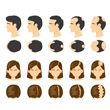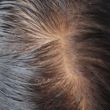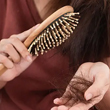Platelet Rich Plasma (PRP) for Hair Loss

Introduction
Platelet Rich Plasma (PRP) therapy has been around for a few years now. Initially, PRP injections were used mainly for treating joint injury, trauma, and wound healing treatments. However, more recently, cosmetologists have started using PRP injections to help rejuvenate hair growth in patients with AGA-induced hair loss.
Platelet-rich plasma therapy involves injecting PRP or platelet-rich plasma derived from the patient's blood directly to their scalp. This is known to improve hair growth and show some astonishing results for those suffering from AGA. If you are considering getting PRP therapy for your hair loss, here are some important things you must know.
What is PRP Therapy? 1,2
There are four main components of blood, namely RBCs, WBCs, platelets, and plasma. Platelet-rich plasma is derived after almost five times more platelets are concentrated into the plasma by processing it in the centrifuge. This platelet-rich plasma is then injected into the scalp at an appropriate depth to accelerate the growth and healing of those tissues that promote hair growth.
The PRP injected into the scalp for hair growth is effective as it stimulates the dermal papilla cells in the scalp that are known to play an extremely important role in hair growth. PRP therapy involves a three-step procedure, where firstly, the blood is drawn from the patient, is processed, and then injected into the scalp to heal and improve hair growth.
Most research regarding PRP therapy for androgenetic alopecia showed that using subcutaneous injections of PRP reduces hair loss and improves hair diameter and density in patients with AGA.
PRP Therapy Process and How It Works? 3,4

The PRP therapy procedure is only prescribed to patients with AGA, and it is not a cosmetic procedure to improve hair volume. It is a medical procedure that a professional doctor can only conduct after a careful medical history and after investigative tests are carried out. PRP is used for scalp rejuvenation and improvement of hair growth in patients, and it is done using the following steps:
- First, the technician will draw out blood from the patient's arm. The sample collected is mostly about 15 to 20ml.
- This blood will then be put into a centrifuge and rotated at a suitable speed to separate the plasma and platelets from the other components.
- The rotated blood separates into layers of PRP and platelet-poor plasma. The doctor then carefully takes the PRP with the help of a syringe and separates it from the sample. In some cases, the doctor may also add activating agents to this PRP.
- Next, this PRP drawn from the sample is carefully injected into the affected area. Your doctor may also apply a numbing cream before injecting the PRP to avoid any discomfort or pain.
The entire PRP therapy process takes up to an hour, and patients can return to their normal day-to-day life after the procedure without any downtime. For best results, the doctor may prescribe several sessions depending on your hair loss.
PRP therapy focuses on injecting the platelets into the dermal papilla cells that help improve hair growth and reduce hair shedding. Research has also found that PRP works best for patients with AGA, where it is used in combination with other treatments. The overall improvement of hair growth will be better if PRP is used along with topical minoxidil, Finasteride treatments, etc.
What is the Cost of PRP Therapy?
One of the important factors to consider before getting the PRP therapy is the cost of this procedure. In India, the cost of this procedure may vary from anywhere between Rs. 5000 to Rs. 15,000. This cost may vary depending on the type of equipment used, the experience and reputation of the doctor, and even the extent of hair loss and the number of sessions needed by the patient.
This overall cost will be higher for extreme hair loss and balding, as this will require multiple sessions. It must also be noted that PRP results are not permanent, and the patient may have to keep getting a few regular sessions to keep the hair growing.
Side Effects of PRP for Hair Loss 1,3

The PRP procedure is a very low-risk procedure, and there are very few chances of allergies too. Since the platelet-rich plasma is derived from the blood drawn from the patient itself, the chances of allergies are almost non-existent. However, the procedure involves injections, so patients may experience mild soreness or pain on the site of injection that usually goes away after some time. Additionally, some less common side effects or risks involved in this treatment are:
- Bleeding at the site of injection
- Tissue damage
- Minor pain and soreness
- Redness
- May lead to infection
- Nerve injury
- Scar tissue
Do consult with your doctor before choosing to undergo this procedure to better understand every risk and side effect according to your medical history.
Who can Get PRP Therapy? 5

While PRP therapy is safe for most patients, the overall effectiveness of this treatment may change if you have certain conditions that keep aggravating your hair fall. The therapy also works best in those patients who have had recent hair loss. It may be difficult for those with old hair loss to activate dormant hair, and the result may be scattered and less effective. Some other patients with the following conditions may also not get the best results from PRP:
- Patients using blood thinners
- Those having thyroid disease
- Those with Lupus
Conclusion
For patients with AGA, the PRP therapy treatment can bring about a lot of relief with hair loss. It has been known to improve hair growth and overall hair density of your hair. While it is a relatively safe treatment option, it may not be as effective for every kind of hair loss.
For better understanding your hair loss pattern, its causes, and whether PRP will work for you effectively, it is best to consult a dermatologist who will help you understand whether to go ahead with PRP and if it may be a good treatment option for you. We would also advise you to consider all the risks and costs associated with it before taking the plunge.
Myth Busters HairFall

Androgenetic Alopecia - Everything You Need To Know
Have you been experiencing excessive hair fall over a prolonged period of time? It could be an early sign of androgenetic alopecia. It is a hair loss disorder common in both genders and can lead to progressive thinning and even baldness in some patients if not caught and treated early.

How To Make Hair Grow Faster For Men
A head full of healthy hair is a matter of confidence. Hair has its own mechanism of growing and shedding, and it is when this mechanism is thrown off that growth is hindered. Especially in the case of males, hair growth faces a lot of hiccups that can easily be managed.

Female Pattern Baldness - Causes & Treatments
Have you suddenly noticed an increase in the number of hair strands on your pillow in the morning? Or is your ponytail getting thinner by day? Well, you might be suffering from female pattern baldness. While that does sound scary, identifying it early on is key to treating this condition effectively. So keep reading to know what this is, how you can identify it, and most importantly, what treatments you can avail of to get your beautiful lustrous hair back.

What Are The Reasons For Hairfall?
Almost everyone experiences some amount of hair thinning over the years. Shedding around 50 to 100 single strands of hair per day is considered normal. However, losing more than 150 strands a day, experiencing sudden thinning, or developing circular bald patches on your scalp are reasons for concern. Hair loss occurs when new hair doesn’t grow fast enough to replace the amount of hair you lose daily. Hair can fall due to various reasons, with hereditary hair loss and poor nutrition being the most common hair fall reasons.

Expert Approved Tips For Hair Growth
What can be more debilitating than seeing hundreds of hair strands shedding from your scalp every time you brush your hair? Also, excessive molting occurs during seasonal changes that can be very stressful for you. Although it’s okay to lose between 50-100 strands every day, according to the American Academy of Dermatology, the problem occurs when you start shedding more than normal. But that doesn’t mean you have to feel helpless as there are ways to grow your hair back. Even if you are coping with baldness or alopecia, certain hair growth tips from dermatologists can come to your rescue. Read on to discover how these tips can be your savior when abnormal hair fall problems are in sight.
Trending Videos
+ 5 Sources
'LMRC - GGI-CO-A2-DMA-300001252-300001252-WM-L21-704'
© 2021 Dr. Reddy’s Laboratories Ltd. All rights reserved.